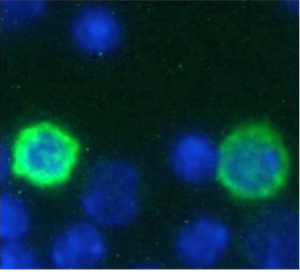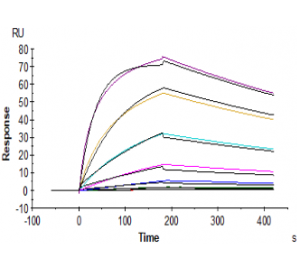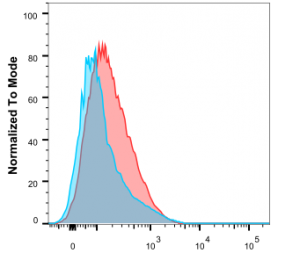![absoluteantibody/Anti-PD-1 [RMP1-14]/100 μg/Ab00813-1.32](https://www.ebiomall.cn/images/no_picture.gif)
Alternative Name(s) of Target: CD279; PD1; PDCD1; RMPI-14; RMP1/14; Programmed Death Receptor 1; Programmed Death 1Immunogen: The original rat hybridoma was generated by immunizing Sprague Dawley rats with mouse PD-1-transfectked BHK cells. A P3U1 myeloma was used as the fusion partner.
Specificity: This antibody binds to murine PD-1.
Application Notes: Binding of the original rat IgG2a antibody to PD1 has been reported to prevent binding of both B7-H1-Ig (PD-L1-Ig) and B7-DC-Ig (PD-L2-Ig)fusion proteins to PD1.
Antibody first published in:Yamazaki et al.Blockade of B7-H1 on macrophages suppresses CD4+ T cell proliferation by augmenting IFN-gamma-induced nitric oxide production.J Immunol. 2005 Aug 1;175(3):1586-92PMID:16034097Note on publication:Describes the generation and initial characterisation of the RMP1-14 hybridoma


Immunofluorescence staining of fixed mouse splenocytes with anti-PD-1 (programmed cell death protein 1) antibody RMP1-14 (Ab00813) Immunofluorescence analysis of paraformaldehyde fixed mouse (Mus musculus) splenocytes on Shi-fix™ coverslips, permeabilized with 0.15% Triton stained with the chimeric rabbit version of RMP1-14 (Ab00813-23.0) at 10 µg/ml for 1h followed by Alexa Fluor® 488 secondary antibody (1 µg/ml), showing membrane staining of a subset of cells. The nuclear stain is DAPI (blue). Panels show from left-right, top-bottom Ab00813-23.0, DAPI, merged channels and an isotype control. The isotype control was stained with an anti-Fluorescein antibody (Ab102-23.0) followed by Alexa Fluor® 488 secondary antibody.


SPR-analysis of different versions of RMP1-14 binding to murine PD-1 Biacore data comparing affinity and binding kinetics of mouse IgG1, IgG1 D265A, IgG2a and IgG2a Fc Silent versions of RPM1-14 to mPD-1.


Flow-cytometry using anti-PD-1 antibody RMP1-14 (Ab00813) Staining of murine splenocytes (unstimulated and 3-day Con A stimulated) with the rabbit-chimeric version of RMP1-14 (Ab00813-23.0) at a concentration of 1 µg/ml for 30 mins at RT. After washing, bound antibody was detected using a AF488 conjugated donkey anti-rabbit antibody (ab150073). Con A stimulation induces PD-1 expression as evident by the increased fluorescence signal.



